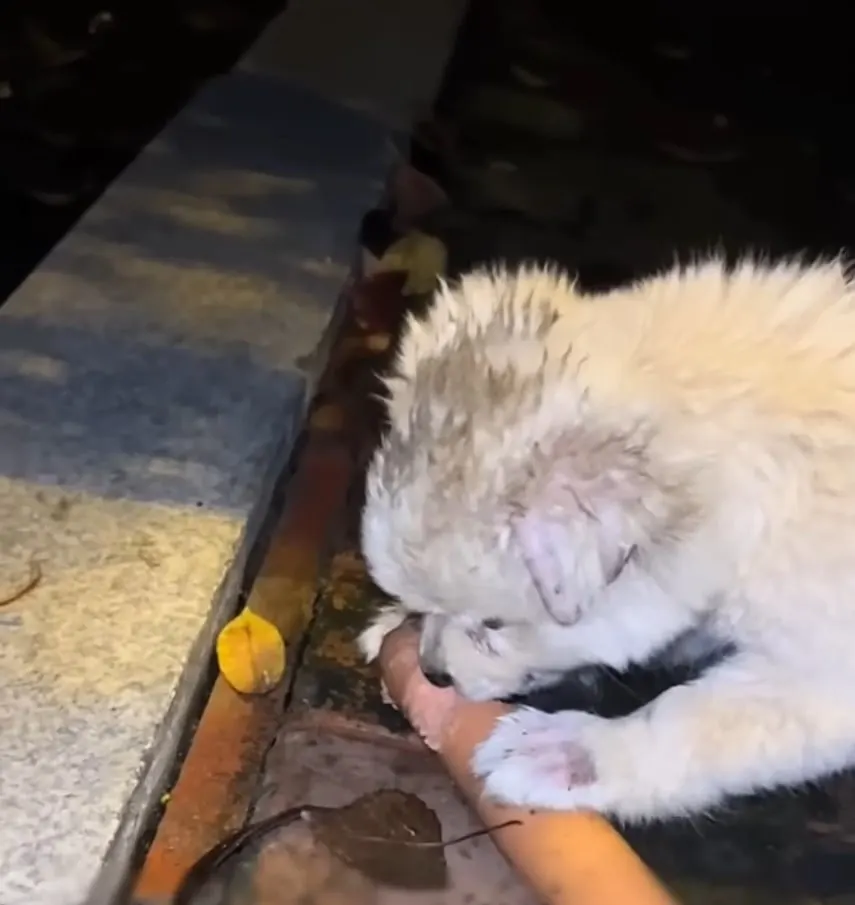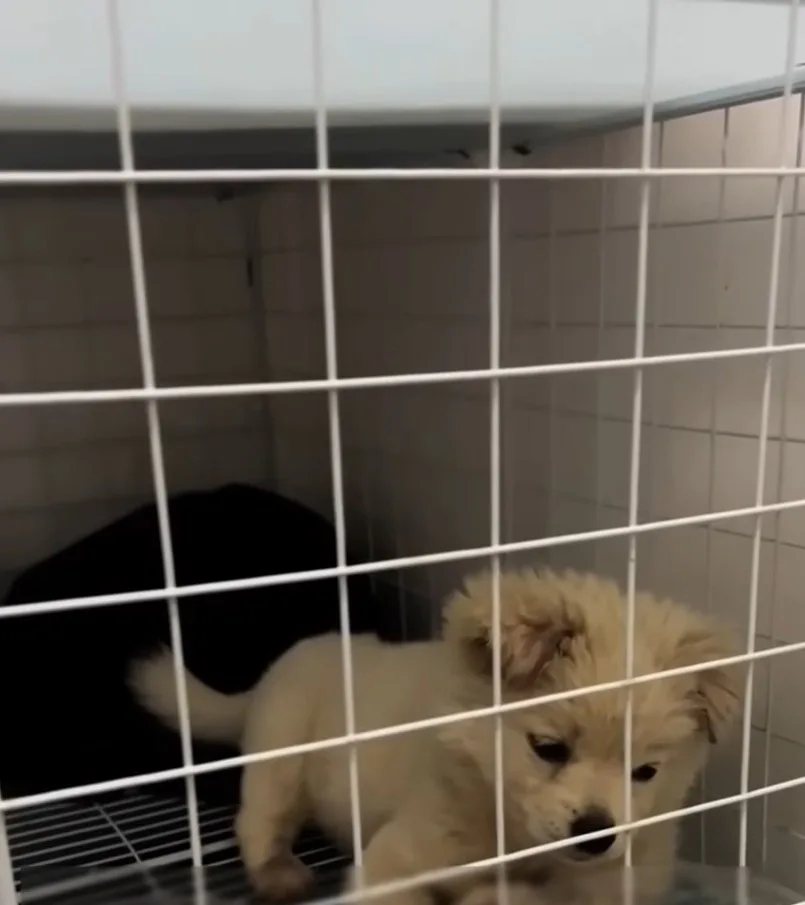One of the most amazing things a person can do to improve his or her life is to adopt a dog. It’s a life-changing experience.
There is nothing quite like it, and most people who have never had one will have a hard time understanding us dog lovers.
So, in this story, we will talk about a small puppy who was begging people to adopt him, but nobody was giving him a chance until he met someone special.
A Very Lucky Day For This Puppy

Then, the puppy revealed himself. He approached them without hesitation and didn’t care that they were strangers.
It was almost like he was asking them to help and adopt him. He looked like he was really tired and malnourished, so they gave him some food.
They were not shocked that he ate it all immediately. He was just really friendly and sweet. The rescuers knew they had to help him.

After looking at him closer, they noticed that he was really dirty, but also had wounds under his feet which needed treating.
He didn’t know anything else other than the place he was at, so he was a bit scared, even though he clearly wanted help.
When the rescuers were passing him by the next day, they noticed he was wagging his tail as they approached. He was happy to see them.
However, this time around, he mustered the courage to do what was needed. He followed the kind people who wanted to help him right to the veterinarian clinic.
He Is So Happy To Finally Have A Home

As for his paw injuries, the vet helped him by treating them immediately, so the entire thing went okay, and it meant that this puppy was going to recover.
In order to help him recover, the veterinarians decided to have him stay at the clinic for a few days until he fully healed so they could monitor him.
After 5 days had flown by, one of the rescuers took the puppy to his home, and they just continued his treatment from there.

In the care of his rescuers, his personality was changing so much. Aside from the fact that he was already really friendly, he became a lot more energetic and playful.
His once-tired face was swapped for a happy one. The rescuers were so happy that he was doing a lot better now, and he just loved being with them.
When it came time to make a decision on whether they wanted to have someone adopt this puppy, they just didn’t have the heart to do that.
They already loved him so much, and they knew he had to stay with them. It was a great thing in the end, as the puppy was more than happy to stay with the people who saved him.
If you’ve ever noticed a strange patch of red, scaly skin on your furry friend, you might be wondering how dogs get ringworm. As a seasoned dog enthusiast, you know that these pesky fungal infections can be a common nuisance for our canine companions. Understanding the ins and outs of ringworm transmission is key to keeping your pup healthy and happy.
Picture this: your dog loves exploring the great outdoors, rolling around in the grass, and mingling with other four-legged pals at the park. Little do you know, these innocent activities could be the gateway for ringworm to sneak its way onto your pet’s skin. Stay tuned as we uncover the surprising ways in which dogs can pick up this irritating infection, and most importantly, how you can help prevent it from affecting your beloved pup.
Understanding Ringworm in Dogs
Ringworm in dogs isn’t caused by worms but by fungi known as dermatophytes. These fungi feed on keratin, a protein found in the outer layer of the skin, hair, and nails of animals, including dogs. Understanding how ringworm spreads and affects our furry friends is essential for effective prevention and treatment.
How Ringworm Spreads
Ringworm can spread through direct contact with an infected animal or contaminated objects, such as bedding, grooming tools, or even soil. When a dog comes in contact with the fungi, it can easily transfer to their skin, leading to infection.
Symptoms to Look Out For
Common symptoms of ringworm in dogs include patchy hair loss, redness, itching, and crusty skin. These signs can vary in severity, and not all infected dogs may show symptoms immediately. Regularly check your dog’s skin for any abnormalities to catch ringworm early.
Diagnosis and Treatment
If you suspect your dog has ringworm, it’s crucial to consult a veterinarian for a proper diagnosis. Diagnosis often involves skin scrapings, hair pluckings, or Wood’s lamp examination to detect fungal presence. Treatment typically includes antifungal medications, topical treatments, and environmental decontamination to prevent re-infection.
Preventing Ringworm
Preventing ringworm involves regular grooming, keeping your dog’s living space clean, avoiding contact with infected animals, and prompt treatment of any skin issues. By following these preventive measures, you can significantly reduce the risk of ringworm in your dog.
Conclusion
Understanding ringworm in dogs is key to keeping your furry companion healthy. By recognizing the symptoms, seeking timely veterinary care, and practicing good hygiene, you can protect your dog from this common fungal infection. Stay vigilant, and prioritize your dog’s well-being to ensure a happy and healthy life together.
Diagnosis and Treatment of Ringworm in Dogs
When it comes to diagnosing ringworm in your furry friend, a veterinary consultation is essential. The vet will conduct various tests to confirm the presence of the fungal infection. These tests may include skin cultures, Wood’s lamp examination, or microscopic examination of skin scrapings. Once diagnosed, treatment typically involves antifungal medications, which can be in the form of topical creams, oral medications, or medicated shampoos.
Topical treatments are often used for localized infections, while severe cases may require oral medications. It’s crucial to follow the vet’s instructions carefully and complete the full course of treatment to ensure the infection is completely eradicated. In some cases, treatment may take several weeks to show full effectiveness.
Along with medication, environmental decontamination is crucial to prevent the spread of ringworm. Cleaning your dog’s living areas, bedding, and grooming tools regularly can help eliminate fungal spores. Additionally, isolating infected pets and minimizing contact with other animals can prevent the spread of the infection.
Regular follow-up appointments with the vet are essential to monitor your dog’s progress and ensure that the infection is clearing up effectively. During these visits, the vet may recommend additional treatments or adjustments to the current treatment plan based on your dog’s response.
By staying vigilant and proactive in diagnosing and treating ringworm in your dog, you can help ensure a speedy recovery and prevent the recurrence of the infection. Remember, early detection and proper care are key to maintaining your canine companion’s good health and happiness.
Preventing Ringworm in Dogs
To keep your furry friend healthy and ringworm-free, follow these preventive measures:
- Maintain Good Hygiene: Regularly bathe your dog with a gentle shampoo to keep their skin clean and minimize the risk of fungal infections. Remember to dry them thoroughly, especially in areas prone to moisture buildup.
- Clean Living Environment: Keep your dog’s living area clean by regularly washing their bedding, toys, and grooming tools. Vacuuming floors and furniture can help remove fungal spores that might be present.
- Isolate Infected Animals: If you have multiple pets and one is diagnosed with ringworm, isolate the infected pet to prevent the spread of the infection to others. Consult your vet for guidance on caring for the infected pet while minimizing the risk to other animals.
- Avoid Contact with Strays: Limit your dog’s exposure to stray or unknown animals that may carry ringworm. Supervise interactions with other animals, especially those with skin issues or hair loss.
- Monitor Skin Changes: Regularly check your dog’s skin for any signs of irritation, redness, or hair loss. Promptly consult your veterinarian if you notice any suspicious changes in your dog’s skin or fur.
By proactively implementing these preventive measures, you can create a safe and healthy environment for your beloved canine companion and reduce the risk of ringworm infections.
Conclusion
So there you have it, the ins and outs of how dogs can catch ringworm. From understanding the causes and symptoms to learning about diagnosis and treatment, you’re now equipped to keep your furry friend safe and sound. Remember, prevention is key! By sticking to good hygiene practices, keeping your pup’s living space clean, and steering clear of strays, you can significantly lower the chances of ringworm making an unwelcome appearance. Stay vigilant, stay informed, and most importantly, keep those tail wags coming!
Frequently Asked Questions
How do dogs contract ringworm?
Ringworm in dogs is usually contracted through direct contact with an infected animal, contaminated objects, or spores in the environment.
What are the symptoms of ringworm in dogs?
Symptoms of ringworm in dogs include circular areas of hair loss, redness, scaling, and crusting on the skin. It may also cause itchiness and inflammation.
How is ringworm in dogs diagnosed?
Veterinarians typically diagnose ringworm by performing a fungal culture, microscopic examination of skin scrapings, or using a Wood’s lamp to check for fluorescence.
What are the treatment options for ringworm in dogs?
Treatment for ringworm in dogs may involve antifungal medications, medicated shampoos, and environmental decontamination to prevent reinfection.
How can dog owners prevent ringworm?
Preventing ringworm in dogs involves maintaining good hygiene, keeping living areas clean, isolating infected animals, avoiding contact with strays, and monitoring skin changes regularly.
[no_toc]

Hey there, I’m Janet Brooks, a dog-loving student from California. I’m all about helping pups in need, especially those without homes. Me and my awesome friends work together to give shelter and love to stray dogs. Oh, and I also write blogs about dogs to share helpful info.